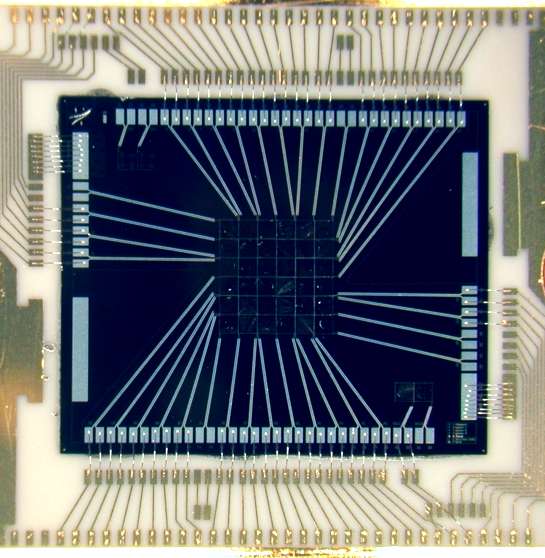Suzaku Special Exhibit
The X-ray Spectrometer

A close-up view of the XRS detector. (Credit: NASA)
Unfortunately, XRS prematurely lost all its liquid helium before observations of celestial X-ray sources could begin. This is all the more heartbreaking because the microcalorimeter is a revolutionary instrument and this was the second try at using one in an X-ray astronomy satellite - the first try was the Astro-E project which failed to reach orbit. ISAS, NASA's Goddard Space Flight Center, and other partners will try again in the upcoming ASTRO-H observatory.
The X-ray Spectrometer (XRS) aboard Suzaku consisted of an array of X-ray microcalorimeters. The X-ray microcalorimeter determines the energy of an X-ray by measuring the temperature change in a piece of silicon when an X-ray hits it. Just as the hood of an automobile warms up when left in the Sun, the silicon heats up when it absorbs an X-ray. The amount that it heats up is proportional to the energy of the incident X-ray.
The X-ray microcalorimeter consisted of a 6 by 6 array of silicon detectors – the entire array measures about 3.5 mm on a side. Silicon itself is not very good at absorbing X-rays, so each detector has a tiny absorber made of mercury telluride. The X-rays heat up the absorber, which heats up the silicon detector.
The temperature increase due to a single X-ray is very small, about 0.001 degrees. To detect this small change, the detector must be kept cold to reduce its own natural thermal energy. The detector was kept at very cold temperatures - 0.06 K, or 0.06 degrees above absolute zero. This is accomplished using a 3-stage cooling process, consisting of solid neon (at 17 K), liquid helium (at 1.2 K) and an Adiabatic Demagnetization Refrigerator (ADR; 0.06 K). The ADR uses the magnetic properties of certain types of salts to cool the microcalorimeter to its operating temperature.
The result is that the XRS could determine the energy of an X-ray to 0.1 percent. If police had radar as accurate as the XRS, you could get a ticket for driving at 100.1 km/hour in a 100 km/hour zone! The XRS is sensitve to X-rays ranging in energy from 0.3 to 12 keV.
Published: July 2005
Text Reviewed: September 2018


